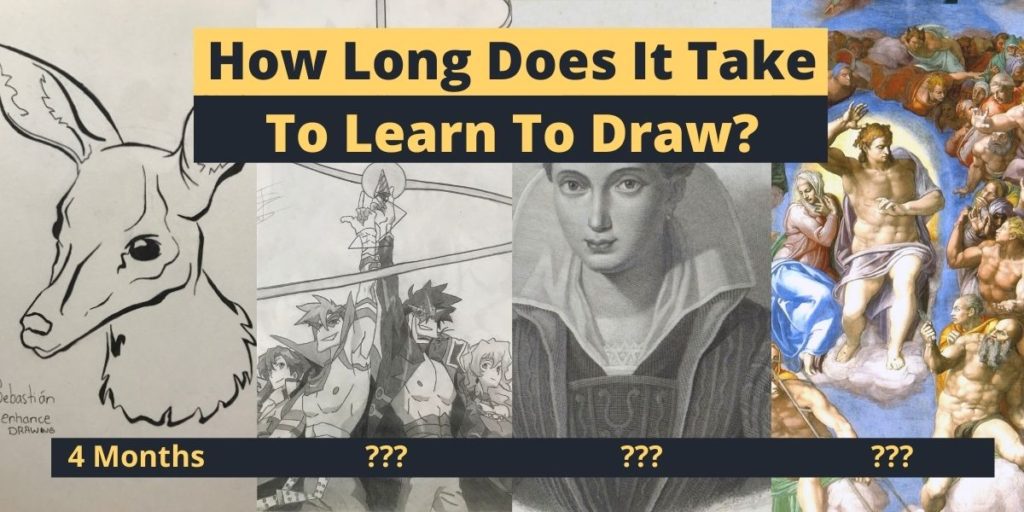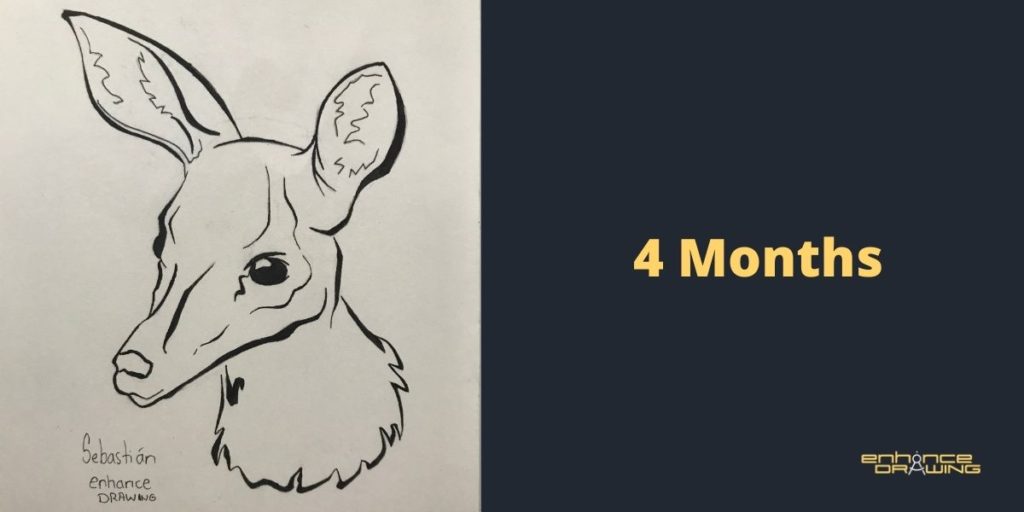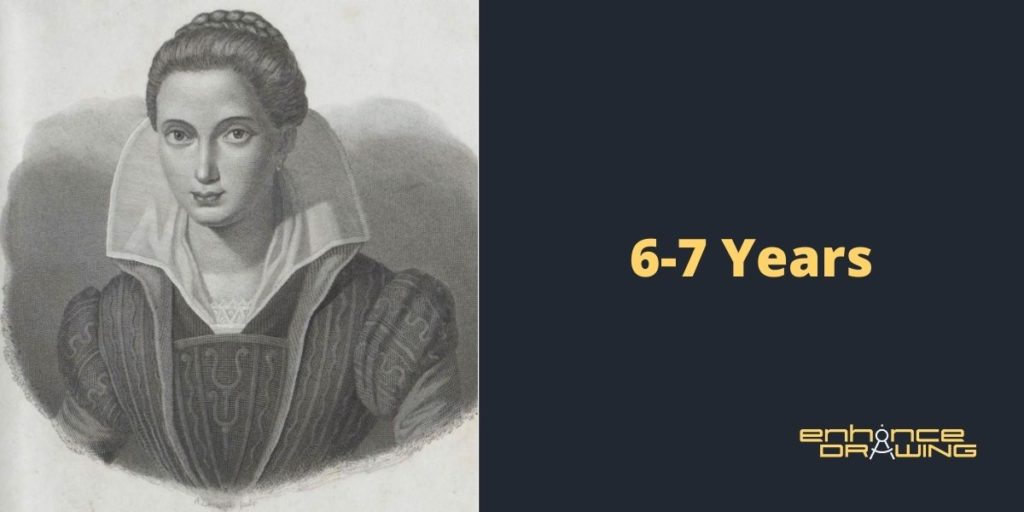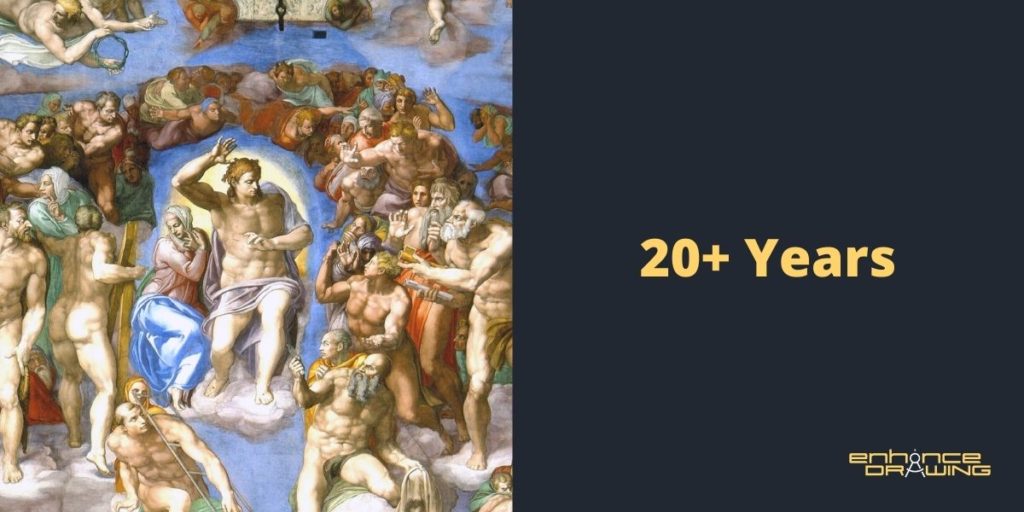
How long it takes to learn to draw is one of the most common questions artists ask in their beginning phases. We ask it for reasons like checking if we’re improving our drawing skills fast enough or considering if we have the time to do it. So, according to my experience and the artists I’ve known in my life, how long does it take to learn to draw?
On average, learning to draw well takes two years. The time it takes any person to draw can be longer or shorter depending on how they approach drawing, the time they practice, and how easy they learn new things. Depending on the artist’s goals, learning to draw can take from one month to years.
Two years work perfectly as an average. But if you want to identify how much time you would take to learn to draw, below are some illustrated examples with different drawing levels and resources that will give you a more accurate answer.
How Long Does It Take To Learn How To Draw Well?
Learning how to draw well is such a personal experience one person can learn to do it in three months, and another one can learn the same thing in one year. The time it takes any person to learn drawing varies because of these five main factors: method, time, consistency, how fast they can learn new things, and what you consider to draw well.
Let’s first talk about what you consider to draw well. To do it, I will narrow down drawing to four different levels: Beginner, Intermediate, Experienced and Expert.
I created all the examples below under these conditions:
- The person doesn’t have any previous drawing experience.
- The person is consistently drawing one hour a day.
- The person has an organized approach to learn drawing (which I talk about later in this post)
- The person doesn’t have any particular gift or talent for drawing.
Time It Takes To Draw Like A Beginner Artist

If your desire to learn to draw started because you saw a drawing like the one above, you’ll probably be able to draw it well in four months. When I say “draw it well,” I mean you can represent the drawing above with 90% or more accuracy.
Time It Takes To Draw Like An Intermediate Artist

To draw like an intermediate artist, you would need to practice drawing for at least two years. At this point, the elements of art you’re applying to your drawings are a bit more complex, and you have a better understanding of value, perspective, and proportions.
Time It Takes To Draw Like An Experienced Artist

The word experience has power in it. Drawing as an experienced artist requires at least five years of drawing practice, theory, and various sets of skills. After five years of consistently drawing every day, it is very realistic you can achieve creating drawings like the above. At this point, you’ll probably be able to draw anything you study.
Time It Takes To Draw Like An Expert Artist

As with any skill, you never stop learning it. Every pro artist there is still saying: “I’m still learning to draw every day.” Everything that drawing encompasses is so much that a lifetime is probably not enough to master all its aspects in many cases. However, to be an astonishing artist, you don’t need to know everything about drawing, but to be very good at its fundamentals and practice your skill. It’s hard to measure the amount of time required to achieve this drawing level proficiency, but I would say you need at least twenty years of consistent study and practice to be among experts.
As the great Michelangelo once said:
“If people knew how hard I worked to get my mastery, it wouldn’t seem so wonderful at all.”
-Michelangelo.
That quote amuses me. It makes wonder, if even someone like Michelangelo had to word so hard to get his mastery, can anyone learn to draw?
To amplify this a little bit, let’s see how much time it would take to learn to draw some of the most popular drawing styles out there.
How Long Does It Take To Learn Different Drawing Styles?
Every drawing style has aspects that can be easier or harder to learn, and there are some styles that if you know how to draw correctly, you’ll probably be able to draw anything afterward. Here are some common drawing styles and the time it takes to learn them.
How Long Does It Take To Learn To Draw Anime?
You can learn to draw anime well in one year, but it commonly takes between three to four years of proper training to be proficient at drawing manga. Depending on how deep you want to go with the manga drawing style, it can take even more. To give you an example, you could maybe draw anime characters very well, but structural drawings, animals, and anything else you can think of in an anime style can take longer to learn.
I have a more detailed article about the amount of time it takes to learn to draw anime if you’re interested in this drawing style.
How Long Does It Take To Learn To Draw Comics?
Even though comics and anime have some similarities, comics are far more realistic than manga-style drawing. You can get to a decent comic drawing level in one to two years, but getting to a proficient level would take much longer. The time it would take someone to draw comics very well is around four to six years of constant studying and drawing practice.
This drawing style takes longer to learn because of the details and apparent differences many characters have. In contrast to the anime/manga style, the presence of anatomy in the comic drawing style is much more noticeable.
How Long Does It Take To Learn To Draw Realistically?
Learning to draw realistically takes an average of five to ten years of proper, consistent training. You can get to an average level in two years, but the number of skills you need to master to draw realistically requires time.
To consider a drawing realistic, it must have proper proportions, lines that resemble the subject’s anatomy correctly, shading, perspective, line quality, and many other things. Realistic drawing can doesn’t have too much room to play around with as different drawing styles have. For example, the manga drawing style creates fictional characters, meaning that you don’t need to draw a subject exactly as it is in real life. However, realistic drawing is a style that requires the artists to follow many rules and to be very precise.
Now you have a clearer and more realistic vision of the amount of time it would take to learn to draw. But all those timelines assume the artist is following a proper approach to learn to draw. Let’s see what factors affect how fast an artist learns to draw.
Drawing Factors And Tips That Can Speed Up Your Learning Time
There’s no doubt you will improve your drawing skills by just drawing anything. However, if you approach learning to draw with a more organized and efficient plan, you will see results much faster.
Here are the steps I recommend you take when learning to draw.
1- Draw Every Day For At Least An Hour
There’s no number of how many how-to-draw tutorials you can read or watch to improve your drawing skills if you don’t take a sheet of paper, a pencil and start drawing. If you can draw for more than one hour a day, by all means, do it; you will achieve your goals faster.
Tip #1: Be patient with yourself. It is normal if you don’t create fantastic pieces of art immediately, so don’t be discouraged by the results at this point. When you allow yourself the time to improve, the results will naturally show.
2- Learn These Drawing Fundamentals
If there’s something I wished I knew before I started to draw is learning the drawing fundamentals. Understanding these is especially important because they will hold you up from learning many bad drawing practices that you would need to unlearn later on (like I had to do.) These fundamentals are:
- Perspective: Everything we see is in perspective, and although we’re so exposed to the concept of it, drawing in perspective is quite a challenge if you don’t know the basics. Most beginner drawings look odd because of this.
- Form: Learning to draw basic figures like squares, triangles, and circles is very beneficial to your overall drawing. It may seem like there’s not a close relationship between these forms and more complex drawings. Still, the reality is that almost anything we draw incorporates these, so it’s essential to understand them deeply.
- Anatomy: And not only human anatomy, but animal anatomy, plant anatomy, and so on. You don’t have to study anatomy to all its extent, as this a drawing aspect that can take several years to master. For now, it’s okay to learn the basics and continue learning as you draw more.
- Composition: This is a widely known concept in photography. Unlike photography, when you draw, there are no limitations of what you can or can’t draw; freedom can make you create unique pieces of art or create art that doesn’t quite compel what you intended. The main drawing aspect you would be learning here is scale and proportions. Having a good understanding of these will help you lead people to see what you want them to see and create more complete drawings. One thing you can do to learn about composition is to see how professional artists do it in their works. Composition in art is a big topic, but just learning the basics is okay to start.
Tip #2: Immerse yourself in what you want to learn to draw. Don’t feel discouraged when you see very talented people! The talent the artists you admire have is a result of the time they have practiced. Drawing is a skill, and you can get to that level too.
3- Use Anything At Your Disposal To Draw
When I was just starting to draw, my drawings lacked a lot of proportion, so it was common they looked off when I finished them, but at least I noticed it so that I could work on a solution. The way I approach getting better at the proportions of my drawings was to use a ruler. I would leave some pencil marks with the drawing’s length and height, where the head would start and finish, and other essential marks to keep my lines in place.
The ruler is just one drawing tool at your disposal, but there are also grids, drawing using references, online tutorials, and many other things. If there is anything you feel can help you achieve your drawing goals, do it or use it.
Tip #3: Not everything you draw must be freehand. Although most of the things you draw will be freehand, any tool you can use to make your drawings look better is not a bad practice. However, if your goal is to improve your freehand drawing, look for tutorials and tips on how to do it properly, although this is usually a skill that naturally develops with time and experience.
4- Identify What You’re Good At Drawing And Improve It
One of the best ways to find your art style is to identify what you’re good at drawing. When you’re good at something specific, usually it is because you naturally like it, so if you continue working on it, you’ll start to develop a personal style. You don’t have to rush this process, just to draw in many different styles until you find what you like.
Finding your style is “essential” because every drawing style requires a certain amount of time to master, and if you try to be a master in every kind, it will take you a lot of time. It is not impossible, though, so if you want to pursue that, by all means, do it.
Tip #4: If you can, find an art teacher or someone to review your drawings. One of the things that will help you learn to draw well faster is to have someone with experience to give some advice. Sometimes, an artist’s lack of knowledge can hold her from seeing mistakes or ways to improve, so having a second opinion will help a lot. If you don’t want someone to review your drawings, enhancing your self-assessment abilities is something I would suggest you do.
Drawing is a skill that takes time to learn, but I’m sure anyone can do it with the right approach and dedication.
How Many Hours A Day Should You Practice Drawing To Learn it Faster?
The minimum amount of time you should draw a day is an hour. But as you may know already, the more you practice anything, the faster you’ll learn how to do it. Drawing isn’t the exception to this rule, and I consider 5 hours of drawing a day is a great goal to have if you want to see improvements quicker. Drawing one hour a day works, but some drawings can take you 10 or 20 hours to finish, or even more. And you will start feeling it is too little time in many cases.
One great way to establish the amount of time you want to dedicate to drawing is to determine how much you want to be a great artist or how important it is for you, and how quickly you want to achieve your drawing goals. These tips won’t only help you take a better approach to learn to draw, but anything else you want to learn in the future.
- How much do you want to be a great artist? If you’re considering drawing every day for years and make this beautiful art part of your life, it is crucial to decide how important drawing is in your life priorities. If you consider drawing just a hobby, it shouldn’t be one of your main priorities; maybe one hour a day is enough. If you think it is more than a hobby, then 2 hours a day might be a healthy amount of time. Or if you’re like me, a person who wants to make drawing and art his living, then giving 5-8 hours a day to it makes sense. Don’t only think about the great feeling of becoming a fantastic artist, but also about the sacrifices and discipline that come with anything you want to pursue.
- How quickly do you want to become a great artist? There’s a book that says you need 10,000 hours of practice to become an expert in anything, which I would say is debatable. However, if we apply this approach to drawing and only draw an hour a day, it would take us 27 years and five months to become expert drawing artists. But if we drew for 5 hours a day and use the same example, it would take us five years and six months to become expert drawing artists. Don’t assume these examples are objective truths! Depending on your training approach, and the type of person you are, learning to draw like an expert could take less or more than that.
If there is something else I can add to this article, I want to encourage you to start this journey and draw. I wish everyone gets to experience the joy, peace, and overall well-being drawing has brought to my life.
Happy drawing!
